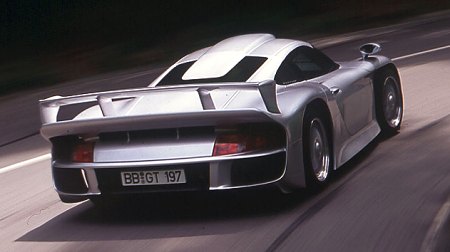 The
international GT championship ran in the late 1990s was supposed to be
a fair competition platform for supercars like McLaren F1, Ferrari F40
and Jaguar XJ220 to prove their performance. Somehow, Porsche found a
loophole in the rules and entered a purpose-built race car. It
deliberately styled the car's front end with 911's headlights, and then
called it 911 GT1 to fool the governing body. To satisfy homologation
requirements, it converted the race car back to two dozen road cars,
sold them to enthusiastic customers and wealthy collectors at DM1.5
million each. This became the rarest Porsche road car of all, if you
can call it a "road car".
The GT1 did share some mechanical parts with the production 911. Its front chassis structure was claimed to be taken from the contemporary 993 GT2. This enabled the cockpit to feature the same dashboard and switchgears as the series production model. However, the similarities ended there. The rest of the car was virtually all new. The rear half of the chassis was a tubular spaceframe structure commonly found on contemporary race cars. It contained a mid-mounted engine – versus the rear-mounted one on 911 – and racing-style double-wishbone suspensions with horizontal inboard springs and shock absorbers. Up front, the 911's MacPherson struts were replaced with another pair of double-wishbones, although this time the shocks and springs were mounted vertically. The cockpit was reinforced with a roll cage, whose extensions to the sills blocked part of the door apertures and made access difficult. Outside, the lightweight Kevlar and carbon-fiber body shell featured massive aero kits to generate the huge downforce that a race car needed.  The early prototypes built for
the 1996 homologation featured the round headlamps of 993. Within a few
months,
Porsche modified it to GT1 Evo. Now it featured 996 headlamps and a
reshaped body shell that was more aerodynamic efficient yet more
stylish – something
necessary to sell the road cars. Most of the road cars were finished in this form. Speaking
of style, the 911 GT1 was not as beautiful as
McLaren F1, of course, because it was designed primarily for functions.
It was no less sensational to look than the McLaren, but its sensation
was caused by the spectacular wings and spoilers as well as its lowness
and massive width of nearly 2 meters.
The roof-mounted duct drew clean air towards a 3164 cc twin-turbo 24-valve flat-six. It was derived from the unit powering 962 (in fact, the whole rear chassis structure was also adapted from that legendary endurance race car). On the race car, it developed 600 horsepower. This was detuned to 544 hp and 443 lbft of torque for road use. As the GT1 weighed only 1150 kg, performance was quite spectacular: 0-60 and 100 mph were possible in 3.8 and 7.2 seconds respectively, while top speed was 191 mph. There were faster rivals though – McLaren F1 was good for 3.2, 6.3 and 240 mph respectively, and there were a few other supercars topping more than 210 mph. The GT1's downforce-oriented shape limited its ultimate speed on the straights of Autobahn.  How did it feel to drive? On
race tracks, the GT1 drove like a dream. Its massive down force and
grip pressed the car firmly on rails in fast corners. Its huge brakes –
380 mm discs and 8-piston calipers up front; 380 mm discs and 4-piston
calipers at the rear – provided race car level of stopping power. The
stiff suspension led to hardly any body roll. On regular public roads,
however, it drove like a nightmare. Although the turbocharged engine
was not as laggy as you might found on some road cars, it sounded very
loud in the thinly insulated cockpit. The heavy gearshift contrasted to
the slickness of production 911. The rock-hard ride and small ground
clearance did not suit public roads other than the smoothest. The lower
the speed the ride got the worse. Naturally, B-road was its enemy. The
steering wheel kickbacked heavily on each bump and road irregularity,
so you needed a firm hand to guide the car to the desired line.
Meanwhile, you would be always aware of its massive width, which
hampered confidence of driving on narrow roads. As a result, its deep
reserve of performance was hardly accessible on anything other than
Autobahn.
Make no mistake, this was a thinly disguised race car. Its existence was solely down to the need to take on GT racing. Did the mission accomplish? Not quite. In its debut year in 1996, the GT1 won a few races, including the GT1 class of Le Mans. Next year, the FIA GT championship was dominated by McLaren F1 GTR intially and then Mercedes CLK-GTR, which was a purpose-built race car like Porsche. Lacking the resources of Mercedes, the Porsche struggled to keep up with competition. The 1998 version of GT1 was essentially an all-new race car, with carbon-fiber chassis and even more race-oriented aerodynamics. Still, it failed to turn around its fortune. Failing to accomplish on road and track, no wonder the GT1 is largely forgotten today.  |